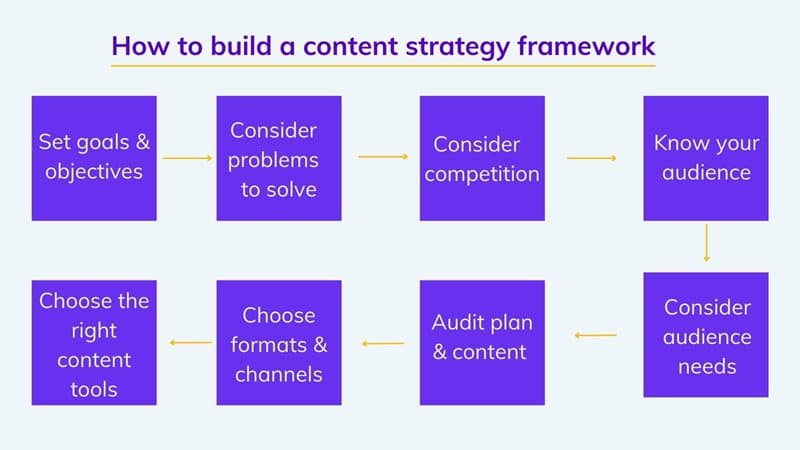
Content Strategy for Websites
EDITORIAL, OPERATIONS.
A good content strategy is essential to deliver to your customers the information they are looking for in the most optimal way.
What is a content strategy?
Digital content includes the text, data, graphics, video or audio available online. A strategy, on the other hand, corresponds to a well-organized holistic plan that seeks a specific objective or result.
A content strategy refers to the practice of planning the creation, delivery and control of useful content that is developed for a brand. A content strategy for the web refers to what a company plans to deliver online and how they plan to deliver it.
A content strategy is necessary to plan the steps that will increase your digital presence and make the user experience so successful that it will allow you to position your brand.
If your customers always find on your website the answers to what they are looking for and the information they need, most likely when it comes to making a purchase or looking for the best reference on the subject you will be the first choice.
Without a content strategy, you are basically working without an organized and measurable plan, creating content that may not be as effective as it should be and for which you will not even be able to assess its degree of effectiveness because you never had a strategy to evaluate it.
For this reason, it is important to keep in mind the five pillars of content creation proposed by Kristina Halvorson in her book "Content Strategy for the Web":
1. Do less, not more. Less content is easier to manage. Remember that you must constantly keep track of the content you share on your website, so less information will allow you to keep everything in order faster. It also provides a friendlier experience for your users.
2. Know what you have and where it comes from. Content strategy is not an easy task. The process required to create, deliver and control content is fueled by information from multiple sources, with humans providing the most input. That means it's not all very well organized, so if you don't know what content you have now, you can't make smart decisions about what needs to happen next.
3. Learn to listen. No one knows better what your customer needs than they do. Even if you think you know what your end users want from their online experience, the only way to really know is to ask them.
4. Designate someone to be in charge. Your organization needs to have a skilled person in charge of all Web content; however, this person will not be responsible for everything. This position has the same duties as an editor-in-chief, responsible for keeping a close eye on your content: what should be created, how it will be put online, and what happens to it once it's on the Web.
5. Start asking, "Why?" When it comes to your business, just because you can create some content doesn't always mean you should. You must first ask yourself if it's really necessary and why it is. Remember:
"By taking a content-first approach, our job as marketers is not to create more content...it's to create the minimum amount of content with the maximum amount of results" (Robert Rose, author of Killing Marketing).
Three steps for content strategy
When talking about creating content, many people think that it is a simple task where all the activities to be performed are created, reviewed and approved. However, a content strategy involves a cyclical process that includes:
Audit → Analyze → Define strategy → Categorize → Categorize → Structure → Create → Review → Review → Approve → Label → Format → Publish → Update → Archive → Archive.
There are several stages for content creation. In addition, it is important to keep in mind that defining a strategy is different for each organization.
The following is an overview of the most important steps to create a measurable and achievable content strategy, as proposed by Halvorson.
Step 1: Audit
The content audit is a step that is often not performed but it is really very important. Auditing allows you to find out what content you have and if it is useful for your audience, or if it is really aligned with the objectives of the proposed project.
Step 2: Analysis
In this phase, the objectives, assumptions, risks and success factors associated with the content of your project are determined. A detailed analysis of all internal and external circumstances that have an impact on the organization's content must be performed in order to determine how those requirements will affect the project schedule, budget or resources.
Step 3: Strategy
During this stage, viable and achievable recommendations are made for the creation, delivery and control of content, informed by the project objectives. This body of recommendations is the content strategy document, which should provide information on how the proposed recommendations will impact the organization and its users. In addition, this phase confirms that all stakeholders understand and align their work with the proposed content strategy.
How to build a reference scheme for your content strategy?
After having defined the basics on that topic, it is important to analyze how a content strategy framework can be built step by step.

1. Set goals and objectives. Spend time outlining your goals and objectives. What are you looking to gain? What are you looking to achieve? And how can a framework help you get there? Define a measurable objective that specifies: what, why and how.
2. Consider what problems it will solve. Ask yourself what problems your content will solve and what solutions you will provide to solve them. Focus on solving your audience's problems.
3. Consider what differentiates you from your competition. To differentiate yourself from the competition, you need to know your strengths and how you can address weaknesses better than anyone else. In this step, describe what specifically differentiates you from your competitors and highlight what makes you special.
4. Know your audience. Focus on a well-defined target audience, such as your buyers, and get to know them in depth. Then, segment your audience by type and ask yourself how you can support your audience segments during each touch point.
5. Consider what's in it for your audience. In other words, how does your audience benefit from reading your content? Consider what your audience will get out of reading your content. Then brainstorm to create a list of tasks that will get your users' immediate attention.
6. Audit your current plan and content. Take some time to review your current content and strategy and ask yourself where you are failing. What goals are you not achieving? What pain points are you not addressing? Finally, think of solutions to update your content and improve it.
7. Choose your channels and content formats. Consider what types of content formats you will focus on, what channels you will publish on, and how you will manage content creation and publishing.
8. Choose the right content tools. Now that you know what your goals are, who your audience is and how you will serve them, it's important to choose the right tools to get there.
This is where you formalize your strategy. Once you have established your content strategy it is important to find a content management system that allows you to quickly create, publish and manage your content on your digital channels.
Contact us
If you are interested in learning how Aplyca can help you transform your web content strategy, do not hesitate to contact us.